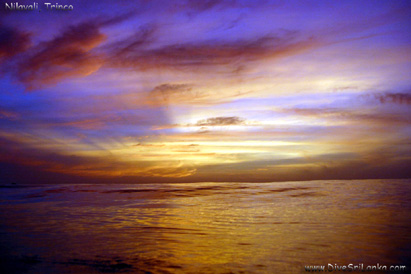
Visit Sri Lanka.
All the hotels that were damaged are now refurbished and reopened! We are now happy to see visitors from Europe, United States, Australia and Asia enjoying well earned vacations in paradises regained.
-------------------------------------------------------------------------------------------------------------------------------------------------------------------------Tsunami 9.0 - The return of the Sea
The day the world changedIt was the beautiful morning of December 26th 2004 AD; the day after Christmas. The place was northwest of Banda Aceh, Sumatra, Indonesia. The first rays of the sun were casting faint shadows of the few fishing boats that were lazing on the gentle swells of the mighty Indian Ocean.
Far beneath the boats, in the oceanic crust many kilometers below the bottom of the ocean, a giant was waking up from an ancient slumber. The Indo-Australian tectonic plate, which had been succumbing to the pressures of the Eurasian plate for millennia, had finally reached its ultimate point of tolerance. In an explosive instant, not unlike the manner of a springboard catapulting an Olympian diver, pent up energies suppressed for centuries were suddenly released into the crust of the earth registering frenzied seismic activity at the United States Geological Survey based in Hawaii. This was later calculated to be a gigantic 9.0 in the Richter Scale.
Along a 1000-mile ridge that formed the subduction zone for the two age old tectonic rivals; the Eurasian plate had risen 30 meters towards the surface and caused one single cataclysmic act of oceanic displacement. A tsunami was born.

Above: A dawn wave brake captured in Nilavali Beach Trinco earlier
during the season is eerily reminiscent of a giant tsunami wave.
Two hours later the first wave reached the Great Basses Reef at Kirinda, Sri Lanka at approximately 0300 HRS GMT. For the first time since Aug 27 1883, in the aftermath of the violent Krakatoa volcanic eruption in Indonesia, the reef was briefly exposed to the air as the sea receded towards the Antarctic.
But this was a Tiger crouching to pounce. When the keepers of the Imperial Light House Service heard the thundering roar and rushed to the windows, the wave had rebounded and was already well past the Basses Reef; an insignificant obstacle for a stupendous force that was now rushing towards the unsuspecting coast of a sleeping paradise island.
In the next half and hour, waves and waves of natures wrath descended upon the idyllic beaches of the island with great force. After a 2000 mile journey that had sapped non of its fury, the Tsunami 9.0 had finally reached Sri Lanka.
It was a busy day at the Unawatuna Diving Center. About 15 divers were enthusiastically getting ready to board the boat. The Dive Master Chaminda had just slung his BCD/Tank and was hauling his other gear to the boat when the first wave hit the center. Chaminda was hurled inland and lived to tell the tale by hugging a lamppost for his dear life. Him and many others were injured.Somadasa and his guests were gearing up at the International Dive Center in Hikkaduwa when the first wave hit them. Someone had the presence of mind to call the Meteorological department to inquire about this unprecedented phenomenon and was warned of a second wave. Everyone at the dive center immediately evacuated to higher ground and also saved countless other lives. The second and the third wave decimated the dive center. Dharshana, an Assistant Instructor, helped many hapless tourists.
Eric Fernando and his guests at the Scuba Sri Lanka Dive Center in Bentota were gearing up when the first waves gushed in. Eric, his team and his guests escaped with their lives.
Delia Zimmler of the Ypsylon Dive Center Beruwala and her team also barely escaped and with serious injuries.
Elsewhere, Warren & Julie Lavender from Calgary, Canada were 20 meters undersea were on their first dive after the PADI OW certification. They felt an incredible current and held onto rocks and coral. They lived to tell the tale.
The east coast was on off-season and all the dive shops were closed. Most of the hotels in the area suffered extreme damages and loss of life. The tsunami's were at its strongest here at ten meters high and reaching two kilometers inland.
An island nation lay stunned in the aftermath of an incident perhaps known to some only in ancient legends. It is said that two thousand years ago, the Princess Viharamahadevi was once cast away in the ocean as a sacrifice to appease the gods of the sea who had ravaged the land relentlessly.
For many tsunami's were an unknown phenomenon. Some lost their lives as a price for their innocent curiosity when the sea receded briefly back to its depths only to return with vengeance.
The seas had indeed returned, perhaps a reminder to all of us the fragility of life we have so focused on pettiness and differences. In an unprecedented show of unity the world is now rising to the occasion. Help is pouring into the affected areas and rebuilding has already begun. In a matter of time paradise will be regained and a better Sri Lanka will be built.
One day the sea will return. It always does. And perhaps the next time we will be stronger, united and better prepared for its arrival. Yet we must humbly remember that the sea is our master; for countless eons ago it gave life to earth. One day, it will take back all it has given.